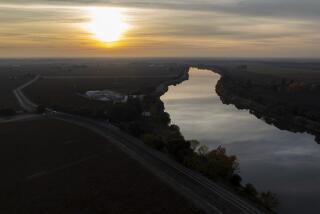Editorial: What’s Gavin Newsom’s plan for sustainable water in California? We still have little idea
Gov. Gavin Newsom’s references to water in his first State of the State address were brief and a bit patchy, but they were enough to make fiercely competing factions each believe the new governor had their backs. Newsom made clear that Jerry Brown’s two-tunnel project to pipe Sacramento River water under the delta to points south was dead, in favor of a single tunnel. The gratified reaction of environmentalists was, essentially: “We killed a tunnel!” The Metropolitan Water District of Southern California said, more or less: “We get a tunnel!”
But water policy in California is never that easy. Two weeks later, we still don’t know much about Newsom’s plans. Knowing we’ll have one tunnel instead of two tells us little. How big? How expensive? For what purpose? The new governor and his team are still working through those questions.
The twin-tunnel plan known as WaterFix was never particularly popular, but it had a purpose. The 30-mile long, 40-foot diameter tunnels would be large enough to take a “big gulp” of excess water during wet winters like the current one, to be shipped south and stored for drier periods. Strict operating agreements would limit them to a “little sip” in dry times, to keep more water flowing downriver when migrating fish need it. They would divert water around the environmentally fragile Sacramento-San Joaquin River Delta, and would allow administrators to periodically shut down the plant at the delta’s south end, where powerful pumps reverse river currents and draw salmon and other fish off their migratory paths.
Newsom has never been a water policy wonk, so the most pleasant surprise is that he appears interested in California’s water challenges.
But they would have been enormously expensive, coming in at around $20 billion. Most water districts in the market for tunnel water opted out, potentially leaving the Metropolitan, its member agencies and their ratepayers on the hook. Delta landowners and environmental advocates questioned whether operating agreements to limit pumping in dry years would hold. If Central Valley crops were dying for lack of water and Southern Californians were rationing while the massive tunnels sat idle, they suggested, surely the deal would be tossed aside and someone would start up the pumps and drain the Sacramento River dry.
Several years ago, the Natural Resources Defense Council and other environmental advocates proposed a single tunnel with about a third of WaterFix’s maximum capacity, ensuring that more water would be left to flow through the delta — but at the cost of a much smaller gulp for farms and Southern California in wet years. The Metropolitan, too, had a single-tunnel backup plan at two-thirds the capacity of WaterFix, but with many of the same cost and mistrust problems of the two-tunnel plan. Newsom’s one-tunnel challenge is to find the right capacity, cost and balance of interests while keeping the factions from walking away. Perhaps he can pull it off. But if you’re the glass-half-empty type, you’ll note that California has been seeking the magic formula for a delta water conveyance for 40 years without finding it, and that in all that time, the problems have only gotten worse.
Newsom also made a lineup change at the important State Water Resources Control Board. Felicia Marcus had guided the state through the drought and, separately, toward a compromise plan to return more water to the Tuolumne, Stanislaus and Merced rivers to sustain salmon populations as they move through the delta. The plan angered agricultural water users, many of whom cheered Newsom’s decision not to reappoint Marcus. That’s ironic, given that Marcus’ vision of California’s water future in a time of climate change emphasized agriculture’s continuing important role.
Enter the Fray: First takes on the news of the minute »
The governor instead elevated water board member E. Joaquin Esquivel to chair, and perhaps that reset can help the board and the San Joaquin Valley irrigation districts reach a settlement that works for both farms and fish. As with the tunnels, though, California has been there and done that without yet actually putting much water back in the rivers.
Newsom’s water signal was clearest and strongest on the subject of safe drinking water for the million or so Californians who currently brush their teeth and take their showers in toxic tap or expensive bottled water. He took top staff on a surprise visit to parts of the San Joaquin Valley where the problem is most severe, and he budgeted $25 million to jump-start cleanup efforts. That’s good news.
Newsom has never been a water policy wonk, so the most pleasant surprise is that he appears interested in California’s water challenges. For the present, though, his exact path forward remains a bit liquid.
Follow the Opinion section on Twitter @latimesopinion and Facebook.
More to Read
A cure for the common opinion
Get thought-provoking perspectives with our weekly newsletter.
You may occasionally receive promotional content from the Los Angeles Times.










